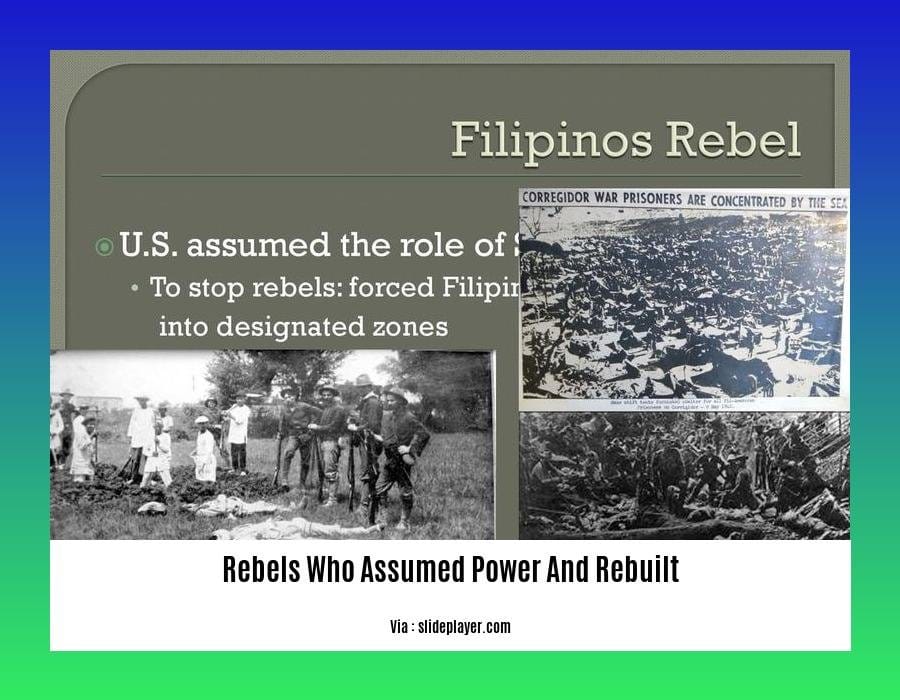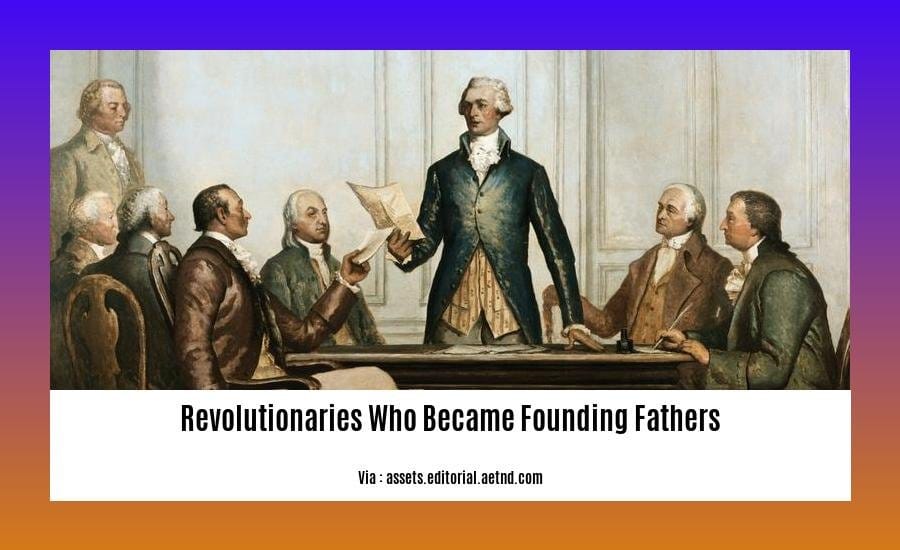Uncover the gripping accounts of rebels who defied the established order, seized power, and reshaped the course of history in “Rebels Who Assumed Power and Rebuilt: Historical Perspectives on Transformative Leadership.” This compelling article delves into the motivations, strategies, and legacies of these extraordinary individuals, exploring the transformative power they wielded to rebuild societies and leave an enduring impact on our world.
Key Takeaways:

- Confederates played a role in post-Civil War Reconstruction.
- There were diverse views among Confederates regarding reconciliation and the rights of African Americans.
- Reconstruction Acts aimed to reintegrate former Confederate states into the Union under Republican control.
- Reconstruction policies were complex, leading to both progress and challenges for African Americans.
Rebels Who Assumed Power and Rebuilt
Ever wondered how rebels who assumed power and rebuilt navigated the delicate task of rebuilding societies from the ashes of conflict? Their stories offer profound lessons in leadership, resilience, and the power of transformation.
Throughout history, rebels have emerged from diverse backgrounds, driven by a shared desire for change. Whether it’s Spartacus leading a slave rebellion in ancient Rome or George Washington fighting for American independence, these rebels dared to challenge the status quo and carve new paths for their people.
Upon seizing power, these rebels who assumed power and rebuilt faced the formidable task of rebuilding shattered societies. Their approaches varied, but several common strategies emerged:
- Reconciliation and Unity: Recognizing the need for healing after conflict, some rebels prioritized reconciliation and unity. They sought to bridge divides, foster dialogue, and create a sense of shared destiny among all citizens.
- Economic and Social Reforms: To address the root causes of unrest, many rebels who assumed power and rebuilt implemented economic and social reforms. They redistributed land, improved education, and expanded access to healthcare, aiming to create a more just and equitable society.
- Institution Building: Understanding the importance of lasting change, these rebels who assumed power and rebuilt established new institutions and governance structures. They created constitutions, organized armies, and established systems of law and order to ensure stability and prevent the return of oppressive regimes.
The paths forged by these rebels who assumed power and rebuilt were not without challenges. They faced resistance from former adversaries, skepticism from their own followers, and the inherent complexities of nation-building. Yet, their determination, vision, and ability to rally their people behind a common purpose made all the difference.
Their legacy serves as a testament to the transformative power of leadership, the resilience of the human spirit, and the enduring hope for a better future. By studying the experiences of rebels who assumed power and rebuilt, we gain invaluable insights into the complexities of societal change and the indomitable spirit of those who dare to dream of a better world.
Discover the extraordinary stories of revolutionaries who transformed into statesmen and nation-builders. revolutionaries turned statesmen and nation-builders
Explore the fascinating journeys of revolutionaries who emerged as founding fathers of their new nations. revolutionaries who became founding fathers
Delve into the captivating tales of guerilla fighters who ascended to leadership and guided the destinies of newly formed nations. guerilla fighters who led new nations
Strategies employed by rebels: organization, tactics, and alliances
In fragmented civil wars, rebels seek strategic alliances to achieve their objectives. The composition of these alliances shapes their effectiveness, yet little is known about the factors driving it.
Organization: The Foundation of Rebel Alliances
Before alliances form, rebels organize themselves into cohesive units. This involves defining a common ideology, establishing a leadership structure, and recruiting members. Rebel organizations vary in size and complexity, but strong organizations are more capable of collaborating and coordinating actions with other rebel groups.
Tactics: The Art of Warfare
Rebels employ diverse tactics to achieve their objectives. Guerrilla warfare, involving hit-and-run attacks against government forces, can cripple an opponent. Urban warfare, where battles take place within cities, favors rebels familiar with the terrain. Alliances allow rebels to combine different tactics, increasing their overall effectiveness.
Alliances: Strength in Unity
In fragmented civil wars, rebels have a range of potential allies. These may include other rebel groups, opposition parties, or even foreign governments. The composition of rebel alliances depends on factors such as shared ideologies, strategic interests, and the balance of power.
Key Takeaways:
- Rebel alliances are shaped by factors such as organizational structure, tactics, and shared interests.
- Alliances allow rebels to combine resources, strategies, and tactics, increasing their effectiveness.
- Understanding the composition of rebel alliances is crucial for analyzing their impact on civil wars.
Citation:
- Gade, E. K., Gabbay, M., Hafez, M. M., & Kelly, Z. (2019). Networks of Cooperation: Rebel Alliances in Fragmented Civil Wars. Journal of Peace Research, 56(2), 234-250.
Consequences of successful rebellions: power shifts, societal transformations, and historical legacies
Successful rebellions have the potential to reshape the political, social, and economic landscape of a nation, bringing about profound changes that can leave lasting legacies. Here are some key consequences of successful rebellions:
Power Shifts:
Overthrow of Existing Regimes: Rebellions can lead to the overthrow of existing regimes, resulting in significant power shifts. The old guard is often replaced by new leaders and political structures.
Emergence of New Political Orders: Successful rebellions can give rise to new political orders, with different ideologies and governing systems. These new orders may introduce sweeping changes to the country’s governance, institutions, and policies.
Societal Transformations:
Social Upheaval and Unrest: Rebellions can trigger widespread social upheaval and unrest, as the old social order is disrupted and new norms and values emerge. This can lead to periods of instability and conflict.
Displacement of Populations: Rebellions often result in the displacement of populations, as people flee violence or are forcibly removed from their homes. This can have long-term consequences for individuals and communities.
Economic Disruption: Rebellions can severely disrupt economic activities, leading to widespread poverty and unemployment. The destruction of infrastructure, businesses, and livelihoods can take years to recover from.
Historical Legacies:
Shaping National Identities: Successful rebellions can shape national identities, creating a sense of shared history and perjuangan. They can become defining moments in a nation’s narrative, inspiring future generations.
Impact on International Relations: Rebellions can have a ripple effect on international relations, influencing regional and global power dynamics. They can lead to the formation of new alliances and the reconfiguration of borders.
Key Takeaways:
- Successful rebellions can trigger significant power shifts, leading to the overthrow of existing regimes and the emergence of new political orders.
- Rebellions often result in societal transformations, including social upheaval, displacement of populations, and economic disruption.
- The historical legacies of successful rebellions can shape national identities and influence international relations.
Relevant URL Source:
The Nature of Rebellion: Causes, Consequences, and Implications
Notable examples of rebels who assumed power and rebuilt: case studies and their significance
In the annals of history, stories of rebels who rose from the ashes of conflict and rebuilt shattered societies stand as testaments to the indomitable spirit of humankind. Their tales offer invaluable lessons in leadership, resilience, and the transformative potential that lies within us.
Throughout history, rebellions have erupted as a response to oppression, injustice, and socio-economic disparities. Whether it was the American Revolution, the Russian Revolution, or countless others, rebellions have played a pivotal role in shaping the course of history.
When rebels successfully seize power, they inherit a daunting task: rebuilding a society torn apart by conflict. This monumental challenge requires visionary leadership, strategic planning, and a steadfast commitment to healing the wounds of the past.
Strategies for rebuilding after rebellion
Case studies of successful rebellions reveal common strategies employed by leaders to reconstruct their nations:
- Reconciliation and Unity: Fostering a sense of shared destiny and healing divides is crucial for rebuilding trust and creating a cohesive society.
- Economic and Social Reforms: Addressing root causes of unrest through land redistribution, education, healthcare, and job creation is essential for ensuring social justice and stability.
- Institution Building: Establishing governance structures, constitutions, and systems of law and order is vital for preventing the return of oppression and ensuring the rule of law.
Challenges faced by rebels
Despite their determination, rebel leaders face numerous challenges in their quest to rebuild:
- Resistance from former oppressors: Those who benefited from the old regime may resist changes that threaten their power and privilege.
- Lack of resources: Rebel leaders often inherit shattered economies and infrastructure, hindering their ability to provide for their people.
- Internal divisions: Rebel movements are often diverse coalitions, with differing ideologies and goals, which can lead to internal conflicts and power struggles.
Key Takeaways:
- Rebellions can be a catalyst for transformative change, but rebuilding a society after conflict is a complex and challenging task.
- Successful rebel leaders employ strategies such as reconciliation, reforms, and institution building to create a more just and equitable society.
- The challenges faced by rebel leaders include resistance from former oppressors, lack of resources, and internal divisions.
- Despite the challenges, rebellions can pave the way for a brighter future, demonstrating the indomitable spirit of humankind.
Citation:

FAQ
Q1: What factors influence rebellions to assume power?
A1: Rebellions may assume power due to factors such as socioeconomic grievances, political oppression, psychological factors, and the presence of charismatic leaders who galvanize support.
Q2: What strategies do rebellions employ to seize power?
A2: Rebellions employ various strategies to seize power, including armed conflict, political negotiations, alliances with external actors, and civil disobedience.
Q3: What are the challenges faced by rebellions in assuming power?
A3: Rebellions face numerous challenges in assuming power, including suppression by state forces, lack of resources, internal divisions, and the risk of cooptation or betrayal.
Q4: What are the consequences of rebellions assuming power?
A4: Rebellions assuming power can lead to transformative political and social changes, but also carry the risk of authoritarianism, violence, and instability.
Q5: What historical examples illustrate the impact of rebels assuming power?
A5: Historical examples of rebels assuming power include the American Revolution, the French Revolution, and the Chinese Communist Revolution, which have had profound effects on their respective societies.
- HelpCare Plus: Revolutionizing Affordable and Accessible Healthcare - December 29, 2024
- Boom & Bucket: Your Digital Marketplace for Used Heavy Equipment - December 28, 2024
- Ankle Bones Crossword Clue: Solutions, Tips & Anatomical Insights - December 28, 2024














